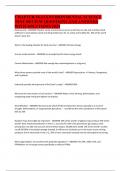CHAPTER 10-13 ENVIRONMENTAL SCIENCE
TEST REVIEW QUESTIONS AND ANSWERS
WITH SOLUTIONS 2024
food security - ANSWER Physical, social, and economic access at all times to safe and nutritious food
sufficient to meet dietary needs and food preferences for an active and healthy life. 10% of the world
doesn't have this
What is the leading obstacle for food security? - ANSWER Climate change
chronic undernutrition - ANSWER not enough food for basic energy needs
Chronic Malnutrition - ANSWER Not enough key nutrients(protein is a big one)
What three systems provide most of the world's food? - ANSWER Aquaculture + Fisheries, Rangelands,
and Croplands
Industrial provides what percent of the Earth's crops? - ANSWER 80%
What are the main factors of soil erosion? - ANSWER Water, wind, farming, deforestation, and
overgrazing water being the highest contributor.
Desertification - ANSWER the process by which fertile land becomes desert, typically as a result of
drought, deforestation, or inappropriate agriculture. -- considered this when production of the topsoil
falls by 10%
Random Facts that might be important: - ANSWER 16% of the world's irrigated crops produce 44% of the
world's food, livestock production in the U.S. accounts for 10% of its greenhouse gas output, meat
pricing does not take into account enviromental impact, 45,000 dams holdd 14% of the world's surface
runoff, 80-90% of municipal sewage dumped, 8 million tons of plastic put in the ocean a year, mining
produces 3/4 of solid waste in the U.S., 50% of toxic chemicals released into the atmosphere by mining,
What organizations are involved with pesticide regulation? - ANSWER The EPA, USDA, FDA, and
FIFRA(there isn't enough money specifically to enforce FIFRA)
, What are some pesticide alternatives? - ANSWER Crop rotation, polyculture, gmo's, pheremone traps,
physical barriers, trap crops.
What does IPM stand for? - ANSWER Integrated Pest Management -- this means using a multitude of
cultivation tactics
What are some practical ways to help conserve soil erosion? - ANSWER Cover crops, wind breaks, alley
cropping, agro-forrestry, tillage farming, organic fertilizer, reducing irrigation dependance,
How can Aquaculture's negative impacts be mitigated? - ANSWER Protect mangrove forests, improving
waste management, reducing escaped fish, set up self-sustaining polyaquaculture systems, certify
sustainable forms of aquaculture
How do we improve food security? - ANSWER produce food locally and sustainably, CSA(community
supported farming), urban agriculture
What is the breakdown of our water use? - ANSWER 70% agriculture, 20% industrial, 10% domestic
Aquifer - ANSWER A body of rock or sediment that stores groundwater and allows the flow of
groundwater.
Groundwater - ANSWER water that fills the cracks and spaces in underground soil and rock layers
What are some ways we can increase freshwater supplies? - ANSWER Building dams, withdrawing
groundwater, converting saltwater to fresh, and reducing water waste.
What are some negative effects of extracting groundwater? - ANSWER Can be depleted, can cause land
sinkage, pollution lasts decades, deeper wells are nonrenewable
What are some negative effects on dams? - ANSWER Depriving the downstream of nutrients, causing
flooding, large loss of water through evaporation,risk of failure and fckng everything up.




